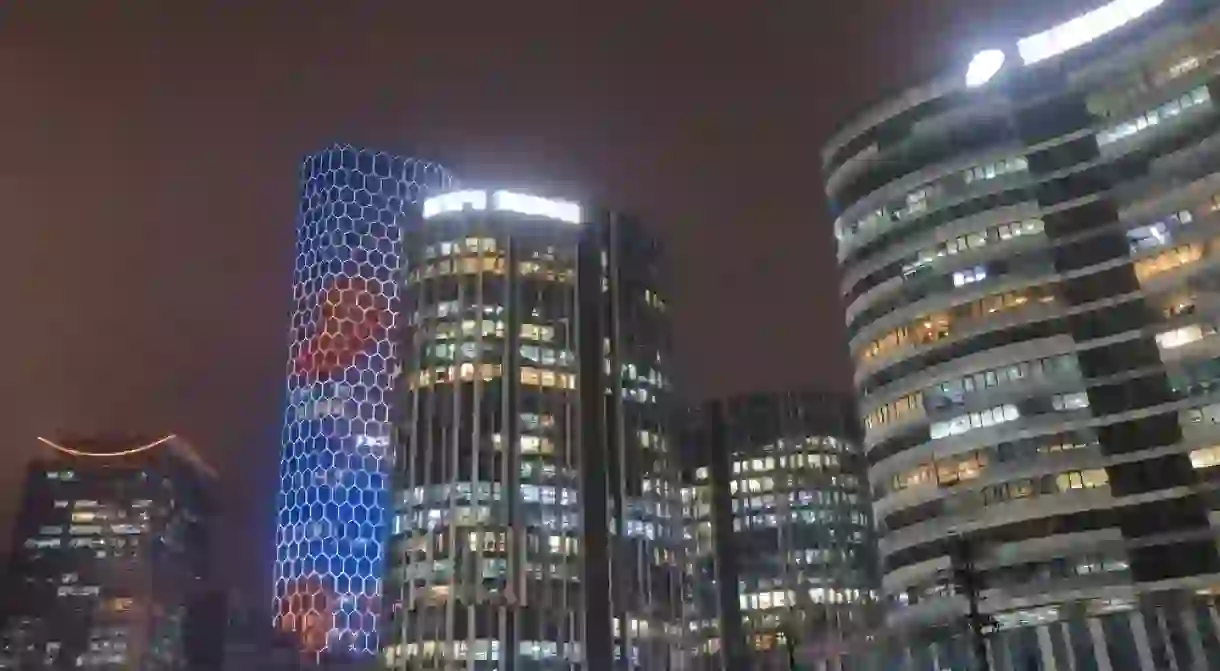The Best Things To Do in Sanlitun, Beijing

The streets of Sanlitun might not be steeped in the same history and culture as some older corners of the Chinese capital, but there’s plenty of fun to be found in Beijing’s booming émigré hotspot. This lively neighbourhood is a hub of food, drink and shopping. Culture Trip has pulled together the things every visitor should see and do in Sanlitun.
Dive into Dirty Bar Street
Bar, Tea Room, Chinese
This Sanlitun institution isn’t as dirty as it used to be – a big clean-up was undertaken before the 2008 Olympics – but this stretch still offers a great night out. The bar boom of the 1990s transformed Sanlitun into the cosmopolitan district it is today, and although demolitions continue to change the face of Dirty Bar Street, you don’t have to search too hard to find a pumping nightclub. The bars around the Workers’ Stadium – Gongti to the locals – are also legendary, as are the late-night food trucks selling chuan’r (barbecued meat skewers) and tang er duo (fried sugar cakes in the shape of an ear).
Wine and dine at Nali Patio
Restaurant, Bar, Contemporary
For a more sophisticated night out, head to Nali Patio, another addition to Sanlitun around the 2008 Olympics. Built in the style of a Spanish hacienda, this multistorey Mediterranean hang-out is loaded with some of Beijing’s hottest bars and restaurants, such as Mosto, Jubang, Agua and Moka Bros coffee on the ground floor. The Hidden City dining precinct and the range of fast-casual eateries around the Workers’ Stadium are other highlights of Sanlitun’s culinary landscape.
Shop till you drop

Shopping has been at the centre of Sanlitun’s regeneration in recent decades, especially the sparkling retail wonderland that is Taikoo Li. Another Sanlitun landmark unveiled in 2008, Taikoo Li is a destination in itself, with 19 buildings, two different sites and countless flagship stores of huge labels like Rolex, Nike, Apple, Armani, The North Face, Longchamp and Adidas, which is the largest Adidas shop on earth. Shopaholics can also get their retail fix at the Soho Nexus Centre, the Shimao Department Store and the 3.3 Building.
Dodge the paparazzi
When you’re walking into Taikoo Li, you can’t miss the mob of middle-aged people snapping your fellow shoppers through their long-lens cameras. No, they’re not here stalking celebrities – they’re just amateur photographers who spend their days snapping Sanlitun’s young, trendy and beautiful locals. Invasive? Yes. But no one seems to mind too much. In fact, many of the involuntary models even stop and pose for the unpaid paparazzi.
Grab a fake at Yashow Market
Market

If you don’t have the budget for a shopping spree at Taikoo Li, then you can find the same big-name labels at Yashow Market… kind of. Yashow Market is renowned for its knock-off clothes, shoes, electronics and everything else you can possibly counterfeit, sold with dirt-cheap price tags. There are also a few silk vendors who tailor bespoke suits if you need some new threads to show off in Sanlitun’s nightclubs, while the nearby Chaowai Morning Market is a good place to find more authentic Chinese produce.
Try a tea cocktail at Long Jing
Bar, Cocktail Bar, Chinese
Peruse the shelves of The Bookworm
Cafe, Restaurant, Bar, Food Court, Bistro, American

Another part of the Sanlitun shopping scene is one of the best English-language bookshops in Beijing. The Bookworm is a café-bookstore that boasts a huge collection of English titles, and also hosts lectures, book clubs, writer talks and even its own literary festival. Book lovers should also visit Page One, a chain focussed on art and design books. The two-storey Sanlitun store sells Chinese literature as well as stationery, gifts and books in plenty of other languages to cater to the area’s large émigré crowd.
Catch a game at the Workers’ Stadium
Stadium

This 66,000-seat stadium was one of the Ten Great Buildings constructed for the 10th anniversary of the People’s Republic of China in 1959, and enjoyed a facelift in 2008 before the Olympics. Gongti is now chiefly a football stadium, home to Beijing Guoan – and the club’s green-clad supporters produce one of China’s best sporting atmospheres inside this monumental concrete bowl. And after the game, you won’t have to go far for a feed or a drink, as countless bars and restaurants are sprinkled around the gates of the stadium.
Stay at the Opposite House
Boutique Hotel

With an ultra-convenient location within the glamorous Taikoo Li precinct, the Opposite House looks like a Rubik’s Cube from the outside. But step inside the six-storey atrium drenched in natural light, and you’ll realise you’ve checked into one of Beijing’s most stylish boutique hotels. The 99 rooms showcase cutting-edge contemporary design, the result of an all-star team made up of Japanese architect Kengo Kuma, London interior designers Neri & Hu and Australian chef David Laris. The Sanlitun neighbourhood is all about eating and drinking, and the Opposite House gets in on the act with three glamorous in-house dining options to sink your teeth into.
Check out these tours and excursions in Beijing
This is an updated version of an article originally created by Fran Lu.













